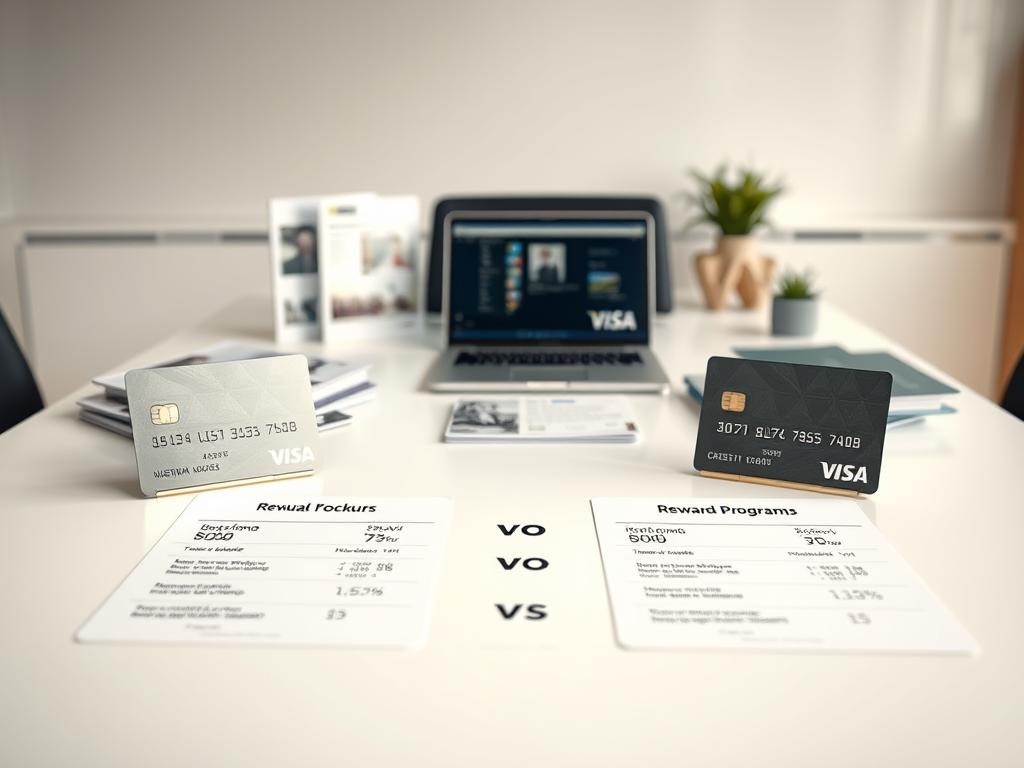Anúncios
Getting a credit card is a smart move for financial growth. It helps build your credit score while unlocking rewards like cashback or travel perks. Before starting the process, understanding the basics ensures a smooth experience.
You must be at least 18 years old to qualify. If you’re under 21, proof of income is required. Lenders check your financial stability, so having documents like your Social Security number and income details ready speeds things up.
Anúncios
Approval times vary. Some issuers give instant decisions, while others take 7–10 days. Whether you’re new to credit or looking for better benefits, knowing the steps saves time and stress.
Key Takeaways
- A credit card boosts your credit history and offers rewards.
- Age and income requirements vary; prepare necessary documents.
- Approval can be instant or take over a week.
- Proof of income is mandatory for applicants under 21.
- Having your SSN and financial details ready simplifies the process.
1. Understand Your Credit Score and Its Impact
Your credit score plays a crucial role in financial opportunities. It affects approval odds, interest rates, and credit limits. Knowing where you stand helps you pick the right financial products.
Anúncios
Why Your Credit Score Matters
Lenders use your FICO score—the most common model—to assess risk. A higher score often means lower APRs and better rewards. For example, Navy Federal’s cashRewards Secured Card requires a minimum score of 580.
How to Check Your Credit Score for Free
You can access your credit report weekly via AnnualCreditReport.com. Services like Experian provide free FICO scores. Soft inquiries (e.g., checking your own score) don’t hurt your rating.
Credit Score Ranges and Card Eligibility
Issuers categorize scores into tiers. Below are common ranges and the cards they typically qualify for:
| Score Range | Rating | Card Types Available |
|---|---|---|
| 300–579 | Poor | Secured cards |
| 580–669 | Fair | Basic unsecured cards |
| 670–739 | Good | Travel rewards cards |
| 740–799 | Very Good | Premium cards with perks |
| 800–850 | Exceptional | Elite cards with high limits |
Hard inquiries (like applications) may lower your score temporarily. Pre-qualification tools use soft checks to estimate eligibility without risk.
2. Choose the Right Credit Card for Your Needs
Your spending goals determine which credit card category suits you best. Whether you want to earn cash back, reduce interest on debt, or build credit, each card type serves a unique purpose. Start by comparing these six common options:
Types of Credit Cards
Rewards cards offer points, miles, or cash back on purchases. Travel cards often include perks like airport lounge access, while cash-back cards return 1%–5% of spending.
Secured cards require a refundable deposit, making them ideal for rebuilding credit. Navy Federal’s secured card, for example, reports payments to bureaus, helping users establish history.
| Card Type | Best For | Credit Score Needed |
|---|---|---|
| Student | College enrollees (2/4-year programs) | Limited/No History |
| Balance Transfer | Paying off high-interest debt | 670+ |
| Secured | Rebuilding credit | Any (deposit required) |
Matching Card Features to Your Financial Goals
Prioritize low APRs if you carry balances. Cards like Citi Simplicity® offer introductory 0% rates, but check standard APRs afterward.
Annual fees trade off against benefits. A $95 fee may justify 2x travel points, but skip fees if you spend minimally.
Avoid store cards despite easy approval—their high APRs (often 25%+) outweigh discounts. Instead, use Citi’s prequalification tool to check eligibility without credit impact.
3. Compare Credit Card Offers
Interest rates and fees can make or break your card’s value. The national average APR is 24.66%, but some offers go as low as 15%. A $5,000 balance at 18% APR costs $1,800 less over five years than at 25%.

Key Factors to Compare
APRs matter if you carry balances. Introductory 0% rates help short-term, but check standard APRs after promotions end.
Watch for these five fees:
- Annual fees (up to $695 for premium cards)
- Balance transfer fees (3%–5%)
- Foreign transaction fees (1%–3%)
- Late payment fees ($40+)
- Cash advance fees (5% or $10, whichever’s higher)
Prequalification Tools Simplify Choices
Tools from Citi, Capital One, and Discover estimate approval odds without hurting your score. Citi requires income and employment details—have these ready.
Other tips:
- Check digital wallet compatibility for contactless payments.
- Compare cashback structures: flat-rate (e.g., 2% on everything) vs. category bonuses (e.g., 5% on groceries).
4. Review the Card’s Terms and Conditions
Legal terms might seem overwhelming, but breaking them down simplifies your decision. Focus on fees, rates, and penalties to avoid financial pitfalls. Issuers must disclose these details in a standardized format called the Schumer Box.
Common Fees to Watch For
The CFPB reports late fees average $32. Other charges can add up quickly:
- Cash advances: 5% fee or $10 minimum.
- Foreign transactions: 1%–3% on non-travel cards.
- Penalty APR: Triggered by a 60-day late payment, raising your interest rate to 29.99%.
Understanding the Schumer Box
This table decodes costs in simple terms. Here’s what to check:
| Term | Example | Why It Matters |
|---|---|---|
| Purchase APR | 18.99% | Your rate for unpaid balances. |
| Daily Periodic Rate | 0.052% (APR/365) | How interest compounds daily. |
*Daily periodic rate calculations multiply your balance by this figure daily. A $1,000 balance at 18.99% APR costs $0.52/day in interest.
5. Gather Required Application Information
Having all necessary details ready avoids processing delays. Lenders verify your identity, finances, and stability before approval. Missing documents can stall your application, so organize everything upfront.
Personal and Financial Details You’ll Need
Standard requirements include:
- SSN or ITIN: Social Security number for citizens; Individual Taxpayer Identification Number for non-citizens.
- Gross income: Recent pay stubs, tax returns, or bank statements for self-employed applicants.
- Housing payment: Monthly rent or mortgage amount.
- Employer contact information (phone/address).
Non-working spouses may use household income if they share accounts with the primary earner. Navy Federal members must provide membership details.
Special Requirements for Applicants Under 21
Federal law mandates proof of independent income or a cosigner for applicants under 21. Acceptable documents include:
- Pay stubs showing consistent earnings.
- Bank statements for freelance or gig work.
- A cosigner’s credit details (if applicable).
Double-check your lender’s rules—some issuers, like Navy Federal, have additional membership criteria.
6. How to Submit Your Credit Card Application
Modern issuers provide multiple ways to finalize your request quickly. Whether you prefer digital convenience or personalized assistance, each method ensures your details reach lenders securely.

Online, Phone, or In-Person Submission
Online portals are the fastest option. Navy Federal offers digital issuance, letting you access virtual numbers immediately after approval. For phone submissions, dial Citi’s line at 1-800-347-4934.
Here’s a comparison of submission methods:
| Method | Speed | Best For |
|---|---|---|
| Online | Instant confirmation | Tech-savvy users |
| Phone | 5–10 minutes | Those needing live support |
| In-Person | Same-day processing | Complex cases (e.g., joint accounts) |
Post-Submission Expectations
Approval time varies. Some issuers respond instantly, while others take 7–10 business days. Capital One provides temporary virtual numbers for immediate use if approved.
If your status shows “under review”, lenders may request:
- Pay stubs or tax returns (income verification).
- Utility bills (address confirmation).
Set up online banking during activation to monitor your account. Link it to payment apps like PayPal for seamless transactions.
7. Handle Application Approval or Denial
Whether approved or denied, understanding the next steps ensures you stay in control of your financial journey. Lenders evaluate applications differently, and your response can open doors or reveal areas for improvement.
Next Steps If You’re Approved
Approval means immediate access to your new account. Call the issuer to activate card features—some provide virtual numbers for online use right away. Here’s what to do next:
- Set up online access: Link your account to payment apps like PayPal for seamless transactions.
- Review your credit limit: Some issuers let you request increases after 6 months of on-time payments.
- Add authorized users: American Express allows up to five free additions, helping family members build credit.
What to Do If Your Application Is Denied
Denials include an adverse action letter explaining the reason. Federal law requires lenders to disclose this within 60 days. Common fixes:
| Issue | Solution |
|---|---|
| Low credit score | Dispute errors via AnnualCreditReport.com or wait 6 months to reapply. |
| High debt | Pay down balances below 30% of your current credit limits. |
| Insufficient income | Apply with a cosigner or explore secured options ($200–$2,500 deposits). |
Navy Federal members can request reconsideration within 30 days. Submit updated income docs or explain extenuating circumstances.
8. Activate and Use Your New Credit Card Responsibly
Activating and using your new account wisely sets the foundation for long-term financial health. Proper management boosts your credit score, unlocks rewards, and avoids costly fees. Start by securing your card and understanding its features.
Activating Your Card and Setting Up Online Access
Most issuers require you to activate card features before first use. Call the number on the sticker or use the issuer’s app—Navy Federal members can generate virtual numbers instantly for online purchases.
Enable autopay for due dates to avoid late fees. First Source data shows paying the statement balance (not just the minimum) saves $450+ in interest annually on a $5,000 debt.
Tips for Managing Your Credit Limit and Payments
Keep your credit limit usage below 30% to maintain a healthy score. Navy Federal reviews limits every three months for eligible users—timely payments increase approval odds.
Maximize rewards by redeeming points or cash back before expiration (e.g., Chase’s 18-month rule). Monitor transactions weekly; the FCBA gives you 60 days to dispute unauthorized charges.
“Secured cardholders who pay on time for 12 months often qualify for unsecured upgrades,” reports Discover’s 2023 customer data.
Conclusion
Smart financial moves start with the right strategy. Focus on three filters: your credit score, preferred card type, and fee structure. Tools like Citi’s prequalification help avoid hard inquiries, which can drop your FICO score by 10 points.
Space out applications—applying for multiple cards at once hurts approval odds. Instead, request credit limit increases every six months to boost available credit. Services like Experian Boost add rent and utility payments to your report, strengthening your profile.
Remember, 35% of your score depends on payment history. Whether you seek travel perks or cash back, patience and research maximize rewards. Now you’re ready to navigate the process with confidence.